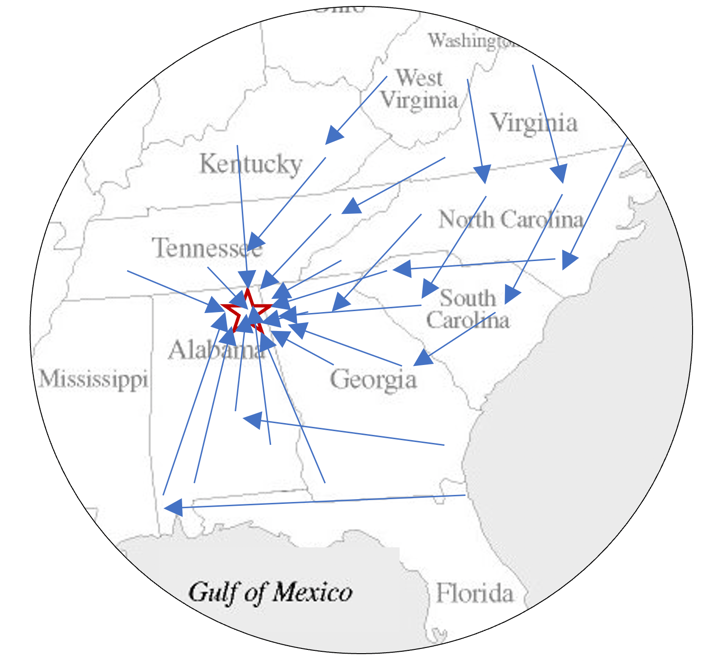On January 11, 1861, Alabama was the 4th state to secede from the Union and Civil War seemed imminent. Three weeks later the Confederate States of America was formed. And on the same date of February 4th, the Apache declared war on the United States. Two weeks later Jefferson Davis was sworn in as the 1st President of the Confederate States of America.

Abraham Lincoln was sworn in as the 16th President of the United States on March 4, 1861. During the following two months, the Confederate Congress adopted a constitution, their forces began an assault on Fort Sumpter, the Union blockade of Confederate ports was initiated, and President Abraham Lincoln declared a state of insurrection in the southern states. The march toward war had reached its destination.
In May, as battles ensued, Richmond, Virginia became the official capital city of the Confederate States. Yet as the war raged throughout the country, life continued as best possible, and people still moved their families to northern DeKalb County.
The many dozens of families that came to settle in the community of what is now called Mountain Home along with those in the Ider, Head Springs, and Pea Ridge communities continued building a life in this place. They deeply loved their family, their God, their neighbors, and their country.
For over 30 years people came to the beautiful lands atop Sand Mountain from many states, and for some, their journey began across the ocean from Sweden, Ireland, Scotland, and Europe. All in search of a better life, a new place to call home where they could build a life, raise their children, and worship God as they learned from their ancestors, the Bible, and others who crossed their path.
While there are plentiful questions and few answers as to how long these neighbors had gathered to worship, or where they met in those early days, we do know that only the cemeteries at Head Springs and Pea Ridge predate that of Mountain Home (based on dated grave markers). There are just under 140 unmarked graves that have no records of who is buried in them; therefore, it is possible that Mountain Home is only predated by Head Springs in the Valley.
During the 1860’s, several families moved into the community that were part of the founding generations. We also know that many of these families banded together and organized the Chestnut Grove Baptist Church on Monday, September 30, 1861. The church at Chestnut Gove held its first Sunday service after it was formally organized on October 6, 1861. Amidst the war raging throughout the nation, Christian people carried on the will of God, followed his biding, and organized His church on Sand Mountain between what we know as Ider and White Oak Gap (Hwy 40 at the top of Sand Mountain). The first pastor was Jacob Williamson Gibson. Jr., born in 1799 in Barren County, Kentucky. He and his wife Elizabeth Franklin moved their family to the community between 1836 and 1839. Reverend Jacob Williamson Gibson, Jr. died in 1862 and is buried at Old Antioch Cemetery near Rainsville.

From the beginning, there was considerable confusion because the cemetery was not located at the same property as the church. In the waning days of the 1800’s and early 1900’s there was an effort to change the name at the cemetery to eliminate the confusion. Initially, as evidenced in several newspaper obituaries, Caperton Gap was used to identify the location of the Chestnut Grove Cemetery, in fact, in February 1910 when George Washington Crabtree’s death was reported in the Chestnut Grove (community) articles in The Fort Payne Journal, “Mr. George Crabtree died at his home near Stamp Sunday morning and was buried at the top of the mountain at the Caperton Gap Monday. He was as old. if not the oldest man in the county, being nearly 93 years old.”
Caperton Gap was used for a period of time, but by the late 1930’s most all references were to Mountain Home. It is unclear at this point when each of the name changes occurred, but we do know the final change was to Mountain Home which did reduce confusion as the cemetery was not co-located with the church itself.
We do know that several of these families banded together and organized the church at Chestnut Grove on Monday, September 30, 1861. The church at Chestnut Gove held its first Sunday service after it was formally organized on October 6, 1861. Amidst the Civil War raging throughout the nation, Christian people carried on the will of God, followed his biding, and organized His church on Sand Mountain between what we know as Ider and White Oak Gap (Hwy 40 at the top of Sand Mountain).
Church minutes taken on September 30, 1861, indicate those present on the day Chestnut Grove Church was founded indicate the names of 15 people present on that day. Of the 15, 13 have been identified and confirmed. Those 13 are:
- Hugh Hamilton Kerby (elected Clerk on this day, and later elected as 3rd pastor of the church) (age 27)
- T. J. (Thomas Jefferson) and Nancy Crow (age 31 and 33)
- James and Louisa Craze (age 43 and 44)
- Mirah Lee Ballard and daughter Minerva Ballard (age 58 and 18)
- Elizabeth Johnson (age 65)
- Leah Bunden (age 19)
- Emily (Margaret Emaline) Lea (age 17)
- J. W. (Jacob Williamson) Gibson (elected pastor on this day) (age 61)
- John Shankles (age 33)
- Thomas Scott (age 42)
- The final two are not yet confirmed; one first name Andrew, but last name unreadable, and the second with a last name of Stegall and a first name unreadable.
One founding family of the church at Chestnut Grove donated land for the first church to be built, and another founding family donated the land for the graveyard known then as the Chestnut Grove graveyard and later renamed Mountain Home to eliminate confusion as the cemetery was not co-located on the same property as the church. Mountain Home was an appropriate name, as it was the final resting place while the Saints waited for the Rapture of the Church, in effect, their final Mountain Home.
As the community continued growing, the entire country did as well, despite the war that raged. In late October 1861, the Transcontinental Telegraph was completed. This was a major accomplishment for a nation of a mere 85 years.
The second elected pastor at Chestnut Grove is listed as S. U. Hastings. However, there is no S.U. Hastings located, in historical records that can be located. However, Stephen M. Hastings has been located, and was a minister, and further is the only S. Hastings with documented burial in the United States that meets the timeline requirements and was a preacher. He served from 1863-1866, and June 1867-May 1868). He was born in North Carolina, raised in Tennessee, and moved to Marshall County in 1817. After a few jumps back and forth to Tennessee, they permanently settled in Scottsboro about 1840. He died in 1901 and is buried at Gold Cemetery at Skyline in Jackson County.
On the national level, the Union forces captured Vicksburg on July 4, 1863. Many other battles and advances on both sides took place in the ensuing months. President Lincoln was elected for a second term and was sworn in on March 4, 1865. Less than three weeks later the Union forces finished the ‘march to the sea’ by taking Savannah, Georgia. In early April as Union forces moved on the Confederate Capital in Richmond, officials in Richmond set fire to the city as they left, and the Union forces moved in to occupy the capital representing the third and final part of the Anaconda Plan.

On July 4, 1863–- Union forces capture Vicksburg, thereby taking the entire Mississippi River (2nd part of the Anaconda Plan). Finally on April 9, 1865, the Confederate States of America surrendered at Appomattox Courthouse, ending the Civil War.
The slow and painful process of reconstruction began before all the dead were counted. The nation was still fractured even though the war was officially over, the healing would take a much longer period.
In the home community, in 1866 the church at Chestnut Grove elected Hugh Hamilton Kerby as their pastor. Interestingly, he was present on September 30, 1861, when the church was founded, and was elected the first Clerk of Chestnut Grove. He was born in 1834 in North Carolina, grew up in Georgia, moved to Alabama and married. He and his wife moved to Tennessee for a time and returned to the community between 1858-1860. He served as pastor at Chestnut Grove from 1866-1867 and from 1868-1873. He died in 1904 and was buried at Pea Ridge Cemetery.
Hugh Hamilton Kerby would have a long and profound impact on Chestnut Grove, in later years, one of his sons would serve as pastor and later still, one of his grandsons would serve as pastor.
EXCERPTS FROM CHURCH MINUTES
July 1866 – First time delegates were sent to the association.
June 1867 – First time deacons were ordained. H. H. Kerby set aside as minister.
As reconstruction slowly progressed, Alabama was the 4th state to be readmitted to the Union in June 1868. In 1869, the 18th US President was sworn into office and the Transcontinental Railroad was completed at Promontory Point, Utah. Albeit slow, the nation was repairing old wounds and moving forward.

The area known as Double Bridges to the southwest known as Townsend Crossroads and continuing SSW was known in the latter half of the 1800’s and well into the 1900’s as Poplar Springs.
It’s 1.8 miles from Chestnut Grove Church to the cemetery founded by the church that now bears the name of Mountain Home.

